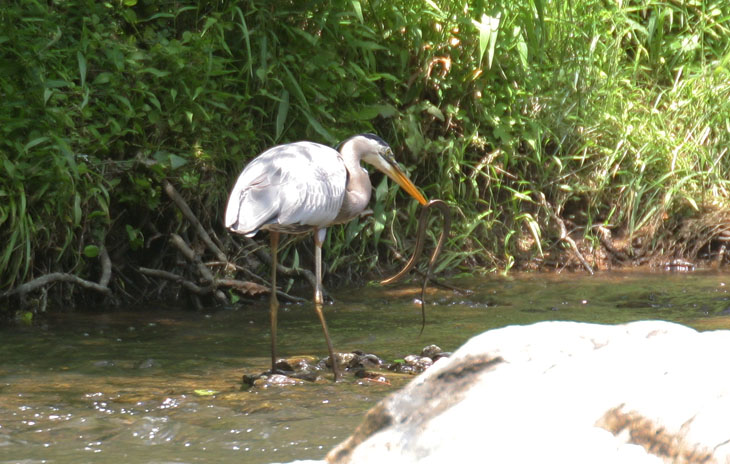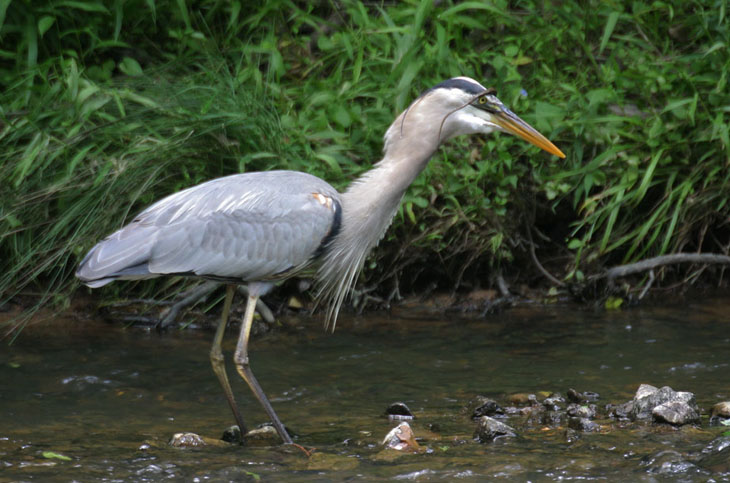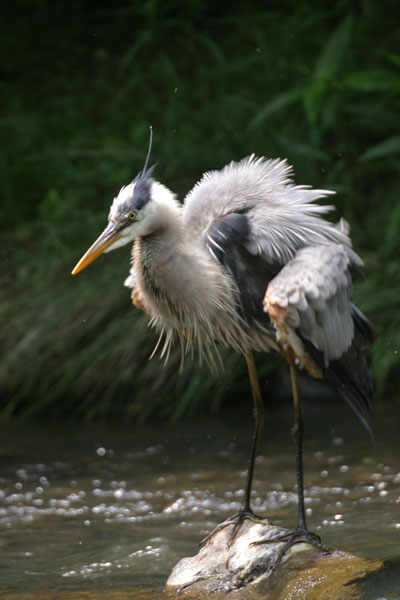
This past Tuesday I met with a student down by the river, and afterward poked around to see what items of interest could be found. In the distance I espied a great blue heron (Ardea herodias) that appeared to be hunting, but a closer look revealed that it had been successful. I hadn’t brought the tripod and thus should not have been shooting with a long lens handheld, but I braced against every available tree as I crept closer, while the light changed rapidly because of passing clouds (note the contrast and the light on the water.)

Herons and snakes have one distinctive similarity: they swallow their prey whole, headfirst, often alive. This is problematic with a meal such as this, because maneuvering a snake around to start it down the esophagus headfirst can be difficult enough with hands, much less by simply flipping and catching it in a different position with one’s beak. On occasion, the heron dropped the snake to take a new grip, but it isn’t as simple as just getting a hold of the head, since the weight of the dangling (and thrashing) body will pull it out of the beak as soon as the grip is loosened rather than letting it start down the gullet, unless the position and inertia is just right.

Once things get started, it all goes smoother, and the heron removed the snake from sight faster than the camera was saving the images. The bird appeared quite irritated by the writhing tail, which to all appearances was the snake’s valiant effort to go down fighting (sorry.)

 With a little stretching and internal adjustment, the snake was gone, and if you’re looking at the peculiar shape of the neck and wondering, yeah, so am I; I wish I could tell you more, but I’d only be speculating. Immediately afterward the heron took a couple of drinks of water, possibly because snakes are drier than fish and herons have minimal salivary glands – they just go down better with a chaser. There’s also the possibility that the heron was picking up a few river stones to aid in digestion, but I have not determined yet if they actually do this. Without teeth, most birds have to break up the tougher foods somehow, and this usually occurs in the crop, a kind of pre-stomach at the base of the neck. A few stones or, in the case of smaller birds, some coarse grit added to the crop serves as grinding surfaces to break down their meals for better digestion.
With a little stretching and internal adjustment, the snake was gone, and if you’re looking at the peculiar shape of the neck and wondering, yeah, so am I; I wish I could tell you more, but I’d only be speculating. Immediately afterward the heron took a couple of drinks of water, possibly because snakes are drier than fish and herons have minimal salivary glands – they just go down better with a chaser. There’s also the possibility that the heron was picking up a few river stones to aid in digestion, but I have not determined yet if they actually do this. Without teeth, most birds have to break up the tougher foods somehow, and this usually occurs in the crop, a kind of pre-stomach at the base of the neck. A few stones or, in the case of smaller birds, some coarse grit added to the crop serves as grinding surfaces to break down their meals for better digestion.
Admittedly, teeth would have been better, at least in the case of avians like herons and raptors which tackle larger, tougher foods. The interesting part is, their distant ancestors the theropod dinosaurs had teeth, and lost them on the way to becoming birds. Obviously they weren’t needed for quite a while, probably because their food sources didn’t require them, being either soft or small enough to be swallowed whole. There’s even an interesting line of speculation that losing teeth lightened the body further to assist in the development of controlled flight. But as food sources changed again, the teeth didn’t return; instead, birds developed different ways of handling coarser meals. Birds of prey like hawks and owls developed very sharp edges to their beaks and talons, to tear their meals apart, while herons developed serrated edges to the beaks, not to break up their meals, but to keep slippery fish from escaping easily. Some seed-eaters have thick bills to crack seeds, and others will simply gobble grains hole and break them up internally; it’s for this reason that lead birdshot and fishing sinkers have been discouraged in many areas, since birds will collect these from streambeds and retain them in the crop, poisoning themselves by absorbing the heavy metal.
 While it might seem ‘easier’ for birds like herons and hawks to simply re-evolve teeth, that’s not how evolution works – even though it might only require a very simple genetic change, since the gene to develop teeth likely remains but is inactive. Genetic change is haphazard, initially random changes, and if it proves to be beneficial to the species it’s more likely to be passed on to the offspring. It could be that a change similar to teeth just didn’t occur again; it could also be that it did occur, but at that point in time it wasn’t useful, since the herons’ ancestor then was not eating snakes and crayfish and such (modern great blue herons will eat about anything – I’ve watched one eat a vole.) Bear in mind that even now, a meal like this serves as only a small percentage of their dietary intake, most of it still being fish, so the advantage of teeth is minimal. The adaptation of different structures at different times in a species’ development, like teeth and talons in the ancestry of a hawk, serves as yet another nail in the coffin of intelligent design; nature is too jury-rigged to be considered planned.
While it might seem ‘easier’ for birds like herons and hawks to simply re-evolve teeth, that’s not how evolution works – even though it might only require a very simple genetic change, since the gene to develop teeth likely remains but is inactive. Genetic change is haphazard, initially random changes, and if it proves to be beneficial to the species it’s more likely to be passed on to the offspring. It could be that a change similar to teeth just didn’t occur again; it could also be that it did occur, but at that point in time it wasn’t useful, since the herons’ ancestor then was not eating snakes and crayfish and such (modern great blue herons will eat about anything – I’ve watched one eat a vole.) Bear in mind that even now, a meal like this serves as only a small percentage of their dietary intake, most of it still being fish, so the advantage of teeth is minimal. The adaptation of different structures at different times in a species’ development, like teeth and talons in the ancestry of a hawk, serves as yet another nail in the coffin of intelligent design; nature is too jury-rigged to be considered planned.
At the end, my model gave a marvelous full-body fluff and shake, though probably not (as some might think) over the idea that it had just choked down a snake. By this time I was eight or nine meters away and it likely decided that was too close, so it calmly launched into the air, flying away gracefully around a bend in the river. I certainly can’t complain.
Another photo essay of a heron’s meal can be found here.




















































